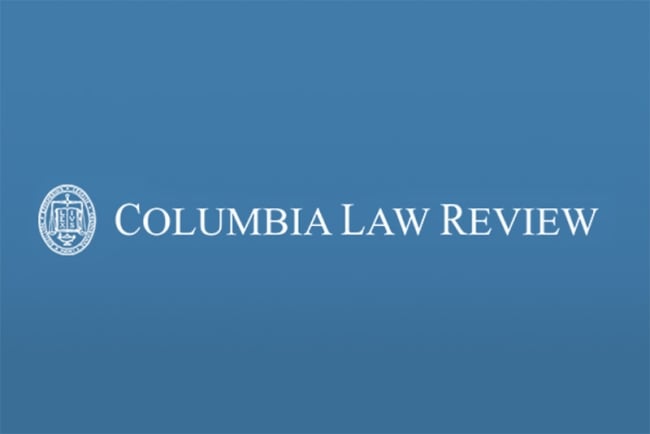You have /5 articles left.
Sign up for a free account or log in.

Screenshot by Elizabeth Redden/Columbia Law Review
The temporary shutdown of the website of the prestigious Columbia Law Review by a faculty-led Board of Directors earlier this month shines a spotlight on how legal scholarship is produced, and who should control it. The facts are not fully clear, with internal allegations of improprieties in the editing process for Rabea Eghbariah’s article on Israel/Palestine; an earlier piece by Eghbariah had been discarded after acceptance by the Harvard Law Review’s website. The Columbia Law Review website has since been restored and the article is now available, arguably with a much wider readership. But while the takedown was always doomed as censorship, it nevertheless directly attacked norms of academic freedom in a way that is insidiously corrosive and profoundly damaging for the long term.
At the core of academic freedom is the exercise of what the American Association of University Professors (AAUP) calls “professionally competent forms of inquiry.” It is not, obviously, a violation when a journal turns down an article because of errors in its method, or when someone is denied tenure because their publications do not meet disciplinary standards. The peer review process, however flawed, is now a central channel for the exercise of those judgments.
But the Columbia Law Review, or CLR, like almost all other prestigious law journals, is not peer-reviewed. Readers from other disciplines may be surprised to learn that law reviews’ editorial boards comprise second- and third-year law students. Twice a year, a small team of such editors select articles from a flood of submissions on behalf of their journal. Some employ a simulacra of peer review—giving external faculty 24 or 48 hours to “read” pieces that are often 30,000 words long. A negative peer review doesn’t always lead to a rejection—albeit for mysterious reasons. In addition to this process of open submission, some pieces are commissioned directly by student editors. A capstone publication for many scholars, for example, may be the Harvard Law Review’s annual “Foreword,” or “Comment” on a Supreme Court case.
This is a system, in short, that vests enormous discretion in student editors: They can toggle between soliciting or taking submissions. If they take the latter path, they have wide latitude. That discretion vests, moreover, in various small teams of editors, not the whole student editor group. In our experience, almost no journal elicits a vote of all its editors when deciding on what to publish. The editors who select and work on a piece play a role akin to journal editors in other fields. They do the work, not for money, but as a signal of industriousness and smarts in the competitive market for prestigious legal jobs.
When we explain this system to colleagues in other disciplines, we’re greeted often with astonishment, ridicule or dismay: It is obviously impossible for law students to exercise informed disciplinary judgment. What on earth could justify this system?
We think the very odd structure of legal publication has a core strength and a core weakness, which were well on display in the imbroglio at the Columbia Law Review. The incident should remind us that law review editors do bear academic freedom rights.
The strength of this peculiar system is its potential independence from entrenched professional hierarchies and blind spots. The Columbia student editors are, no doubt, top of their class: First-rate intellectuals, albeit still in formation, they exercise a kind of raw judgment that can winnow out a lot of chaff without being blinded by old prejudices. Many ideas now central to public discourse emerged through articles selected by student editors. Critical Race Theory is now pervasive in many fields, but that is because of student editors. Kimberlé Crenshaw’s coining of intersectionality came in a 1989 article published in the University of Chicago Legal Forum. A century earlier, Samuel Warren and Louis Brandeis coined “The Right to Privacy” in a Harvard Law Review article. It was an idea with legs.
One of the system’s weaknesses is that students still depend on their home institution's faculty not just for guidance, but for recommendations and professional support. As a result, there is a pervasive “insider” bias in publications. A 2013 study examining bias in legal scholarship confirmed that law journals tend to publish disproportionate numbers of home-institution scholars, and that these articles are cited less frequently than those by outside scholars. That is, Columbia Law faculty can more easily publish in the Columbia Law Review, and these publications will, one could expect, be of lower quality overall.
One of us was an editor at the CLR in 2000–01, and can confirm that faculty at the time exercised a certain pressure on articles editors to take their work. Some faculty were understood to be critical recommenders for prestigious clerkships; their work appeared often in the Review. Sometimes, influence doesn’t need to be expressed to be acutely felt.
For these reasons, being published in a prestigious law journal is probably far less correlated with academic quality than it is in other fields. Nevertheless, the sheer number of law journals, and the care of the student editors, means that more ideas can be published, and they are improved by close editing.
Now think about how the Board of Directors’ shutdown decision shapes these pluses and minuses. It imposed a severe penalty on student editors’ independent judgment. While the shutdown was never likely to keep Eghbariah’s work from the world, the allegations of procedural impropriety in editing affixed a scarlet letter to the current set of student editors, who responded with a strike. The reputational effect is particularly pronounced because the Board did not just delay one article, or shut down one webpage: The whole CLR page, with dozens of other articles and essays, was yanked. This severe and indiscriminately censorious action was dramatically disproportionate in relation to its proffered justifications.
On the other hand, the Board’s action might exacerbate the in-house bias that mars law review already. Members of the Board of Directors include Columbia faculty members and the dean of the law school. Other members are alumni, some former government lawyers, now working at elite law firms. They are thus the people faculty call when trying to help students secure jobs. They are gatekeepers of professional opportunity for many of the students.
The 1940 AAUP statement on academic freedom starts by affirming the need for “full freedom in research and in the publication of the results.” The system of publication in the legal academy, with its reliance on student editors, never provided an ideal environment for that liberty. The decision of the CLR Board of Directors to shut down the journal’s website demonstrates some of the weaknesses in the system. The response should be to recognize that our collective delegation of editorial decisions to students entails their exercise of the corresponding freedom.








